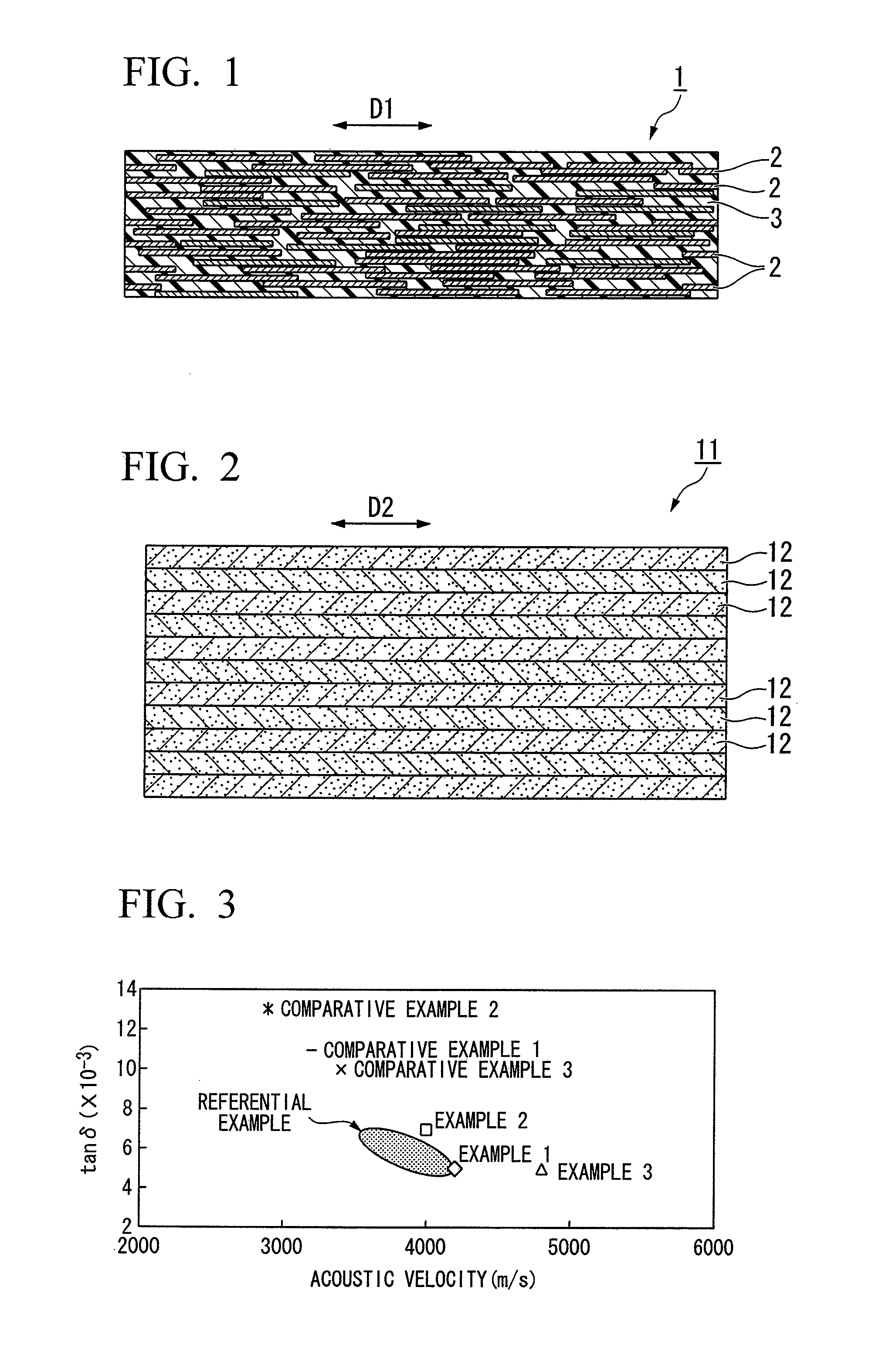Acoustic timber for musical instrument
a technology for acoustic timbers and musical instruments, applied in the field of acoustic timbers for musical instruments, can solve the problems of easy cracking and fractures, heavy impact on the environment, and dispersion of sound quality, and achieve good anisotropy, good sound quality, and good tone color
- Summary
- Abstract
- Description
- Claims
- Application Information
AI Technical Summary
Benefits of technology
Problems solved by technology
Method used
Image
Examples
example 1
(a) EXAMPLE 1
[0059]First, blasted bamboo fibers with an average thickness of 0.3 mm were cut into pieces with a fiber length of 500 mm. Blasted bamboo fibers whose fiber lengths were prepared in advance were soaked into an acetone-methanol mixed solution which included a hardening agent and an unhardened epoxy resin (e.g. JER828 manufactured by Japan Epoxy Resins Co. Ltd.) at a concentration of 50 weight-percent, wherein the final impregnation factor of the epoxy resin was adjusted by controlling the soaking time. Blasted bamboo fibers were extracted from the solution at a suitable time when adequately impregnated with the epoxy resin and then dried in the atmosphere for one day.
[0060]Thereafter, blasted bamboo fibers impregnated with the epoxy resin which were uniformly aligned in the fiber-aligning direction were put into the molding equipment and were then subjected to heating and compressive molding under the desired condition, i.e. at the heating temperature of 200° C., the sur...
example 2
(b) EXAMPLE 2
[0061]First, defibrated bamboo fibers with the average thickness of 0.5 mm were cut into pieces with the fiber length of 50 mm. These bamboo fibers were mixed with a hardening agent and powder in which an unhardened epoxy resin (e.g. JER1002 manufactured by Japan Epoxy Resins Co. Ltd.) was ground into particles with the average particle diameter of 0.1 mm. The final impregnation factor of the epoxy resin was adjusted by controlling the mixing ratio of the epoxy resin with bamboo fibers. Then, bamboo fibers impregnated with the epoxy resin were put into the molding equipment such that they were uniformly aligned in the fiber-aligning direction.
[0062]Bamboo fibers impregnated with the epoxy resin were subjected to heating and compressive molding under the desired condition, i.e. at the heating temperature of 200° C., the surface pressure of 10 MPa, and the pressurized time of sixty minutes, thus producing an acoustic timber of a rectangular parallelepiped shape in the des...
example 3
(c) EXAMPLE 3
[0063]A birch veneer of 500 mm×40 mm was prepared and sliced with the thickness of 0.6 mm, wherein the fiber-aligning direction agreed with the longitudinal direction. The birch veneer was soaked into an acetone-methanol mixed solution which included a hardening agent and an unhardened epoxy resin (e.g. JER828 manufactured by Japan Epoxy Resins Co. Ltd.) with a concentration of 50 weight-percent. Then, the birch veneer soaked in the above solution was decompressed and was impregnated with the epoxy resin in the vacuum condition. The final impregnation factor of the epoxy resin was adjusted by controlling the soaking time. The birth veneer was extracted from the solution at a suitable time when adequately impregnated with the epoxy resin and then dried in the atmosphere for one day.
[0064]Ninety birch veneers impregnated with the epoxy resin which were uniformly aligned in the fiber-aligning direction were put into the molding equipment and subjected to heating and compre...
PUM
| Property | Measurement | Unit |
|---|---|---|
| length | aaaaa | aaaaa |
| lengths | aaaaa | aaaaa |
| pressure | aaaaa | aaaaa |
Abstract
Description
Claims
Application Information
 Login to View More
Login to View More - R&D
- Intellectual Property
- Life Sciences
- Materials
- Tech Scout
- Unparalleled Data Quality
- Higher Quality Content
- 60% Fewer Hallucinations
Browse by: Latest US Patents, China's latest patents, Technical Efficacy Thesaurus, Application Domain, Technology Topic, Popular Technical Reports.
© 2025 PatSnap. All rights reserved.Legal|Privacy policy|Modern Slavery Act Transparency Statement|Sitemap|About US| Contact US: help@patsnap.com


